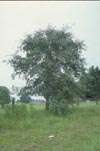Home >
Quercus incana, Bluejack Oak
In nature it is a scrubby oak often found in deep sandy soil. In cultivation, the tree behaves nicely growing into a medium sized oak tree for residential or urban landscapes. It may be one of the best kept secrets of the forest - this is a beautiful tree virtually undiscovered by urban inhabitants. At first glance this tree looks like a young live oak but closer inspection shows blueish foliage, furrowed bark and cupped leaves.
Trees occur naturally throughout north and central Florida south to Lee County and Titusville.
It would make a good candidate for use as a street tree or for parking lot situations. It is very tolerant of drought and should make a great addition to urban landscapes. It is especially suited for planting in parking lot islands, along streets and in other areas with restricted soil space. Trees tend to have a dominant leader and wonderfully showy bark. Trees in Gainesville in parking lots islands have done very well.
Foliage undersides are whitish probably lending drought tolerance to the tree. Chlorosis due to micronutrient-deficiency can occur on high pH soil. Oak wood is considered ring porous to semi-ring porous. Oaks serve as larvae host plants for the brown duskywing butterfly (Erynnis horatius) and the gray hairstreak (Strymon melinus).
National champion is 54 x 54 feet in Florida.





